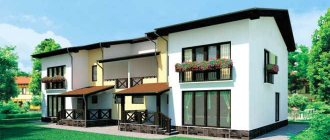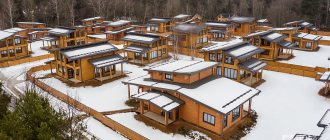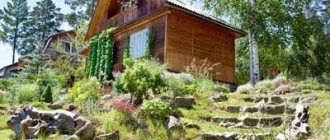A duplex is a separate country house, divided by a common wall into two halves under a common roof, designed to accommodate two families.
In recent years, words such as “duplexes” and “townhouses” are increasingly appearing in advertisements for the sale of residential real estate and on developer websites. In this article we will find out what these newfangled names mean and how such residential buildings differ from each other.
If you are not yet familiar with the concept of a “townhouse,” we suggest that you familiarize yourself with it in our recent publication “What is a townhouse and its features.”
Let's figure out the name
The word “duplex” itself translated from English means “double”, “two-sided”. We can say that a duplex house is two cottages united by one roof and a common side wall.
Each independent part of a duplex is considered an individual residential building. Each half has all the necessary communications, a separate entrance and a small (up to 8 acres) garden area. Overall, this is a budget option for cozy country housing.
Based on the price category, duplexes are divided into 2 categories: economy class and luxury.
Types of duplex houses
| Economy class | Lux | |
| Purpose | For small families, average income level | For wealthy families |
| Number of storeys | 1 or 2 floors | 2 or 3 floors |
| Layout | Mirrored, only the most necessary rooms, small area | First floor - common areas; the second - bedrooms; third - additional premises (terrace, sauna, cinema, billiard room, etc.) |
| Construction Materials | Budget (houses made of cinder block, frame, laminated timber) | Expensive, high quality (brick) |
How to print on both sides?
Duplex or two-sided printing is an optional feature of a printer or all-in-one that automatically prints an image on both sides of the paper. The result is a fairly inexpensive printing process, which provides more opportunities for creating finished products. This could include informational brochures, greeting cards, student documents and more.
Duplex printing in printing equipment can be automatic or semi-automatic. The second operating mode, in turn, is divided into built-in and software. It is important that in both cases manual intervention is required during printing.
In terms of automatic duplexing, before you start printing a document, you can set the duplex properties and page layout. Typically, the machine prints the first page first, then the sheet is retracted by rollers and the image is printed on the other blank side. The finished sheet is then returned to the paper input tray, and a new sheet is pulled from the output tray. A laser MFP will become an indispensable assistant in a small office where it is necessary to prepare invoices or copies of contracts and official documentation. In everyday life, on the contrary, the printer is found in a number of applications, with the exception of some school topics.
Note! To find out if your printer can operate in duplex mode, refer to the technical documentation provided by the manufacturer. If you are planning to purchase printing equipment only of this class, it is enough to consult with the seller when purchasing.
The first duplexes in history
The history of duplexes dates back to the 19th century in England - these were houses with extensions that allowed grown-up children and their families to live in close proximity to their parents. Moreover, each housewife had a separate kitchen, and everyday issues did not overlap. The idea of semi-detached family houses was also popular in Europe - middle-income families appreciated the possibility of building a family home on a budget, and the sections of the house were not identical in structure and layout. Over time, the mirror layout took root, that is, duplexes began to be designed with sections symmetrical to each other, with separate entrances.
In Russia, duplexes appeared in residential areas of large cities as luxury housing, despite the small building area, prices for fashionable houses were prohibitive. Currently, duplexes are affordable real estate for the middle class - buying a house in a duplex is cheaper than purchasing an entire cottage, and living conditions are almost identical.
A Russian feature of duplexes is the acquisition of them by different families, which explains the desire to fence off their part of the local area with a fence. The original position of such housing as family housing is being eradicated in our country.
Duplex - what it looks like, features
The term "duplex" in real estate, which some people mistakenly use as duplex, refers to the construction of a house that is designed separately for two homeowners. One homeowner lives on the left side, and another on the right. In this case, it is possible to design both a single entrance and a separate entrance for each family. The plot of land, as well as the courtyard area, are common, but divided into component parts. A duplex house is no taller than three stories, but in most cases it is a two-story structure.
The history of this type of property begins more than 150 years ago in the UK. Then an additional part of the house was specially built for second-generation families. Duplex came to Russia after townhouses in the nineties.
The main advantage of duplex compared to houses with many apartments is that they do not have uniform specific requirements for construction. The owners themselves choose the desired layout, communications, location of rooms and all other characteristics. Such facilities are built either outside the city limits or in so-called residential areas. In the latter case, it will be a class of luxury housing, since land within the city for construction is much more expensive.
The difference between domestic duplexes and foreign ones is that relatives usually live in such houses abroad, but in Russia a duplex is most often occupied by families that are unfamiliar to each other, which can create problems in living.
Architectural features
A duplex is designed according to the same principles as a regular cottage. Considering the growing popularity of this type of housing, modern architects are creating a variety of projects for economy class duplexes for 2 families, including individual architectural designs.
The main factors that you should rely on when choosing a duplex project:
- layout;
- number of floors;
- common and living area;
- wall material;
- type of roof.
The design solution for a duplex house must satisfy both families who plan to live under one roof. The layout, the area, the size of the local area, and the exterior decoration should be satisfactory. From the outside, the house should have a single harmonious design and give the impression of a solid architectural structure. In recent years, owners of duplexes, by mutual agreement, are decorating their houses in European, high-tech or modern style.
Video description
See the 3D project of a duplex with a garage in the video:
Duplex project with plinth
Three-level cottage for 2 families. There is a ground floor where all the technical rooms are located - a garage with a workshop, a storage room, a boiler room. The presence of a basement increases the convenience of living, but also makes building a house more expensive.
This house has a common porch and adjacent loggias. It is suitable for one large family with separate household management. For example, one duplex apartment can be occupied by elderly parents, and the second by their children and grandchildren.
An important nuance is that the house has a minimum of space allocated for bathrooms, while the second floor hall is quite spacious. This is not to say that such a layout is irrational, but its features need to be paid attention to.
Layout of a duplex with a garage in the basement Source yurlkink.ru
Spacious duplex project
Solid respectable duplex. It contains some features that need to be taken into account when choosing.
- Garages are located as far away from the center of the building as possible and provide additional protection for the premises from heat loss.
- At the entrance there is a double buffer zone, which at the same time separates the garage from the living quarters.
- The living room is designed very spacious.
- The kitchen-dining room can be completely separated from the living room.
- The house has two corner terraces - upper and lower.
- There are dressing rooms on the first and second floors.
This house will be an excellent home for a large family that values comfort. The living space is distributed very competently and concisely.
Spacious, respectable duplex house project for two families Source nika-estate.ru
Layout and location of rooms
The layouts of duplexes and townhouses are similar: most often there are two floors, “mirror” sections, and a similar layout of rooms. On the ground floor of such houses there are common rooms - a kitchen, living room, bathroom, utility rooms, on the second - bedrooms of family members, an additional bathroom, possibly a dressing room and a balcony.
An interesting fact: in the United States, duplexes with an additional third section, common for two families, have recently begun to be built. It may contain a children's playground, a gym with exercise equipment, billiards, a laundry room, a cinema, or a common spacious living room for receiving guests, etc.
Nuances when planning duplex houses
The internal layout of such real estate may differ in different parts, despite the unity of the external facade. The layout of a classic duplex includes:
- a dining room, a kitchen, as well as a living room and utility room located on the lower floors;
- bedrooms are located on the floors above;
- mirror construction of parts and their layout on both sides of the duplex.
Modern elite versions of duplexes are increasingly equipped with common areas: gyms, billiard rooms, laundries, cinemas. These additional territories are used by both owners.
Duplex: pros and cons
The reasons for the popularity of the new type of housing lie in its obvious advantages:
1) Affordable price.
For owning a home on land, the cost of a duplex is very reasonable, and the buyer receives not only a country house, but also an adjacent plot of land with a parking space and a personal garage. Saving on building materials and general utilities allows the developer to get by with a minimal budget.
2) Convenient location.
Duplexes in Russia are built on lands intended for dacha buildings. But the construction of townhouses and cottages on agricultural lands is prohibited. The infrastructure of a dacha area is most often formed, the optimal distance from the city with which transport links are established.
3) Energy intensity.
Duplexes are energy efficient and innovative homes. Designers take into account the location of the building relative to the cardinal directions - the facade of the house is often made of glass and faces the south. This allows you to reduce the cost of heating rooms by using natural sources of heat and light.
4) Relationships with neighbors.
In a house with two owners, neighbors are on only one side, it is easier to agree and resolve common issues. Duplexes, which are close to luxury housing, are purchased by mostly wealthy people, so the risk of scandals and domestic “squabbles” is minimized.
As for the disadvantages, one of the negative aspects of living in a duplex can be noise from the neighboring section. But this issue can be resolved at the design stage or during finishing by using a special building material with air layers, which significantly increases sound insulation performance. An additional obstacle to the spread of sounds will be storage rooms and utility rooms located along the adjacent wall.
Rarely, but possible problems associated with the use of a common yard. If neighbors cannot agree on how to use a common area, you can install a fence and separate your yard. The more disagreements between neighbors, the higher the fence! Although in practice, most often, a children's or sports ground, a recreation area, a swimming pool, a gazebo with benches are installed on a common territory, a garden is planted - by agreement between the residents, and families living under the same roof become friends and help each other in every possible way.
Advantages and disadvantages
The advantages of duplex include the following:
- lower cost compared to cottages;
- permanently protected area;
- modern layout;
- high level of sound insulation;
- reduction of home maintenance costs due to general communications;
- availability of an equipped personal garage;
- a combination of the advantages of a city apartment and country housing;
- suburban location, which guarantees a favorable environmental situation;
- fewer neighbors.
The negative aspects of such a house include:
- noise behind the wall, which is common (if the neighbors are noisy, this issue can be resolved with the help of additional sound insulation);
- undesirable neighborhood: to avoid unpleasant surprises in the future, it is recommended to get to know potential neighbors before purchasing real estate;
- the need to carry out internal repairs, which also requires investment: developers usually do not carry out internal work, so you will have to organize this process yourself, which will require not only time, but also financial costs.
Before purchasing a duplex, you need to weigh the pros and cons of such a premises. The ideal option would be if two families connected by family ties live in a house of this type.
Townhouse or duplex?
Having appeared in Russia relatively recently, this type of suburban housing, such as townhouses, was able to quickly gain popularity. This is a block house of eight or more sections, united by a common roof and load-bearing wall. Duplex construction is only gaining momentum. Many people think that duplexes are a type of townhouse, but in reality they differ from each other in several ways.
Several families (eight or more) move into a townhouse and are built mainly outside the city, while duplexes are designed to accommodate only two families, and can also be built within the city. These two types of modern houses differ in cost - townhouses are more affordable (saving on building materials and the general communications system), the cost of constructing duplexes is slightly higher.
As for the land plot, the owners of duplexes receive up to 8 acres, while the yard of a townhouse accounts for up to 4 acres of land. Utility bills are generally identical; individual meters are installed in both types of households.
Manual duplex booklet printing (Windows only)
Hand-double-sided booklet printing allows you to create folded booklets in half. When creating booklets, the inside is printed first (after folding the booklet). Pages outside the booklet are printed when you reload the paper into the printer.
When creating a booklet, pages 2 and 3 are printed on the first page of the sheet, pages 6 and 7 on the second, and pages 10 and 11 on the third. After you reload paper into the cassette tray, you can print pages 1 and 4 on the back side of the first sheet, pages 5 and 8 on the second sheet, and pages 9 and 12 on the back side of the third sheet. The resulting sheets can be folded in half and bound into a booklet.
Note:
| This feature is not available on Mac OS X. |
Printer settings
Follow these steps to create a brochure.
|
Draft for printing low-quality proofs;
Text to print pages containing only text;
Text and Image for better printing of pages containing text and images;
Photos of good quality and fast printing;
The best photo for the best print quality.
Select the front tray for the source). Select the appropriate Type option). Select the appropriate size). Select the orientation of your print: portrait or landscape). Click the Page Layout tab, then select Manual for duplex printing. Then select the Folded Booklet checkbox). Click the Settings button to open the Settings dialog box. Specify the edge of the paper where the binding will be placed. You can select Left, Top or Right).
Note:
| If portrait orientation is selected, only the left and right edges will be available. The top edge can be selected for binding if Orientation is set to Landscape). |
| In the Units field, select cm or inches. Then specify the binding width |
- Enter a binding width value between 0.3 and 3.0 cm (0.12 and 1.18 inches). The specified value will be applied to both sides of the bend. For example, if you specify a 1 cm margin, you enter a 2 cm margin (1 cm on each side of the fold).
Click OK to return to the Page Layout window. Click OK to save the settings. Load paper in the paper tray and send a print job from the application. When you print the outer pages, you will see instructions for printing the inner pages. Follow the onscreen instructions to reboot the card.
Note:
| The paper may curl depending on the amount of ink used during printing. In this case, bend the paper slightly in the opposite direction before loading it into the machine. Before loading into the printer, straighten the stack of paper by lightly tapping it on a hard, flat surface. Load paper as described in the instructions. Otherwise, the paper may become wrinkled or the binding width may not be correct. |
| After reloading the paper, click Continue to print the inside pages. |
| After printing is complete, fold the pages and staple or otherwise secure them. |
Comparison of duplex and apartment
A family planning to purchase real estate is faced with a difficult choice - save money and buy a compact apartment on the floor, or invest a large amount for the purchase and buy housing on the ground. The table below shows a comparison of an apartment and a duplex house according to the main parameters.
| Duplex house | Apartment | |
| Location | Ecologically clean building area outside the city, fresh air | Urban environment, gas pollution |
| Land plot | Up to 8 acres in property | Public yard only |
| Neighbours | On the one side | Top, bottom and sides |
| Parking | Individual parking space | Whoever was the first from the neighbors took the free place |
The advantages of semi-detached houses on land are not limited to this table - a garage, the absence of noisy elevators and dirty entrances, more spacious living space, neighbors with a common social status, the ability to add premises in the yard and much more. Living in the city has such advantages as modern infrastructure, a developed public transport network, and walking distance to important social facilities and recreational facilities.
Architectural nuances of duplex houses
Duplex houses are designed according to the same basic parameters as standard cottages. There are distinctive features of the architecture:
- Enlarged window openings. Architects most often plan such openings with access to the east in order to heat the living space using the sun and reduce heating costs.
- Facade in the same style. The interior of a duplex in two sections is often opposite, but the external facade is always made in the same style.
- Two floors. The most common solution, although there are also three-story houses and one-story structures.
- Unified system of engineering structures. Heating communications, water pipes, wiring, gas supply - one system for both parts of the house.
- Lots of free space. The average living area of each department is 150 m2.
- Own part of the land. The duplex is being built on a plot of 15-30 acres of land and each family gets its own half, where they can grow fruits, vegetables or have a rest.
- Mirror layout. In both sections the layout is either similar or simply the same.
Increasingly, foreign versions use construction with three sections, one of which is a common area for two families. More often, this layout is used when a duplex is purchased by related families or good friends.
Word settings
Printing both sides of text on paper is easy if you understand Word commands.
- Select "file" then print. A window will appear on the monitor.
- Specify the necessary settings in the window, for example, for a contract. Select the print device connected to your computer system.
- Place a marker on both sides of the printout and indicate the desired range of sheets that will be output from the machine. On the Number of Copies tab, set the number of copies required.
Two-sided printing
Click "OK" to begin the printing process. Sometimes your device does not support duplex text printing. Then you need to turn the paper over and put it back in the machine. If your device has a two-sided printing feature, the sheet will print without human intervention.
The significant difference between a duplex printer and a non-duplex printer is its size. Duplex models are larger because additional space is required to return sheets using other methods. However, recent developments already make it possible to place a duplex module inside the case, and it is no longer possible to visually distinguish the model from the usual and widespread one. But when refilling with toner, such a printer is no different from devices that do not have such a printing option. Before starting the download, the user sets some settings. In practice, the device works like this:
- Only one side of the paper is printed at first.
- The paper is then caught inward by the rollers.
- The second time it passes through the cavity of the photograph, where the toner in the form of an image is already magnetized.
- It is then re-magnetized onto the paper and the material goes into the oven. For the same reason, the paper turns out hot or even hot.
- The paint burns to the coating, and the output is a sheet with data on both sides.
- The finished job is sent out, and the next sheet is pulled from the paper feed container.
IMPORTANT! If, after the process is completed, a warning appears on both sides asking you to turn the sheet over, the device is not considered duplex.
Duplex printers
To find out if the machine you're interested in supports duplex printing, you can check its specifications for that information. It can also be recommended by sellers in online stores or regular stores. The manufacturer invariably indicates this data on its website in the description of the equipment.
Equipment with the Duplex function or “automatic feed” will cost its owner much more than the usual option without such “chips.” But the money invested will quickly pay off thanks to more convenient and faster operation of the equipment.
If you don't plan to print often and typically use the equipment every day, you can safely purchase budget inkjet options that can also print in color. But when it comes to choosing an office device, productivity comes first.
Which company to choose products:
- Samsung: These printers are initially inexpensive, but maintaining cartridges requires more resources than others. Often the equipment of this company requires flashing.
- Copier: the situation is similar to the previous option. But if you need a professional device in a large office, we can only recommend this manufacturer.
- Canon: Makes regular duplex all-in-one printers for the home and small office. Refilling cartridges will not be a problem even for inexperienced users.
- HP: Like Canon, the company makes reliable equipment. Most consumables do not have a chip and do not require replacement.
- Kyocera and Brother are products of these Japanese companies that have appeared on the market relatively recently. But they managed to win their role. The technology is reliable and durable. The benefits of refueling and maintenance are a controversial issue. It all depends on the specific model.
Peculiarities
It’s worth noting right away that in terms of operation, printers with duplex printing are no different from conventional printers. They come with an add-on module that allows you to somehow redirect the sheet of paper so that printing is done on the other side.
More recently, this addition took up a lot of space and made the printer more bulky. However, in the latest models, the duplex module is located inside the housing. Therefore, without this ability, it is impossible to distinguish a duplex printer from a purely visual model.
Advantages
Duplex printing can be useful in a variety of situations. Imagine you need to print a large document. If you're using a regular printer, you're forced to print the even-numbered pages first, then manually turn the paper over and restart printing, but this time on the odd-numbered pages. This approach requires more time on your part. In addition, there is a risk that the stack of paper will be placed incorrectly and the print on the other side will be upside down.
If you use a duplex printer, these problems will not occur. The user just needs to send the requested range of pages to print, but specify in the settings that this should be done using duplex printing. In addition, all work is performed automatically. At this time, the user can begin performing other tasks.
Typically, when printing a document, only one side of the paper is used, which is placed in a special tray. However, duplex printing is often required, which allows text to be printed on both sides of the paper. This technology is used in a number of inkjet and laser printers and MFPs. But it should be noted that a device with this printing method is not considered a device in which, after printing, a message like “go to the printer and turn the sheet over” appears on one side.
The function of a duplex printer is not to turn the sheet of paper over, but to feed it in a different path. So the paper passes through a photo roller where the toner has been previously magnetized into a pattern, which is then re-magnetized onto the paper and the nearly finished print goes into the oven. In it, the coloring matter is burned to the surface of the sheet, and a sheet with an image printed on both sides comes out of the device.
Sources
- https://printeru.info/poleznoe/duplex-i-avtopadatchik
- https://univer-irk.ru/czvet/mfu-chto-eto-takoe-dlya-chego-nuzhen-princzip-dejstviya-i-raznovidnosti
- https://printreality.ru/kak-pecatat-s-dvuh-storon-na-printere/
- https://lazarevo-adm.ru/dupleks-v-printere-chto-eto-takoye/
- https://geekpad.ru/duplex-in-the-printer-what-it-is-additional-options-in-printers-and-mfpssssss.html
- https://lkard-lk.ru/dom/kak-pechatat-na-printere-s-dvuh-storon-kak-nastroit-dvuhstoronnyuyu-pechat-na-printere-kak-pravilno-napechatat-broshyuru-s-dvuh- side
- https://setafi.com/elektronika/printer/dupleks-v-printere-chto-eto-takoe/
- https://128gb.ru/duplex-duplex-printing-duplex-is-what.html
[collapse]
Who is a duplex suitable for?
Usually this is a house where close relatives live: parents and children, brother and sister, uncle and nephew. A duplex helps you save money: instead of two separate houses, you build one. This saves money on conducting geotechnical surveys and connecting communications to the house.
Sometimes strangers live in duplexes and put a fence between the sections. In this case, the very meaning of a duplex as a home for loved ones is lost.
Therefore, a duplex is more suitable for relatives. They get the opportunity to live side by side, but conduct their lives separately and as they see fit.










